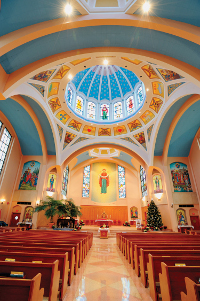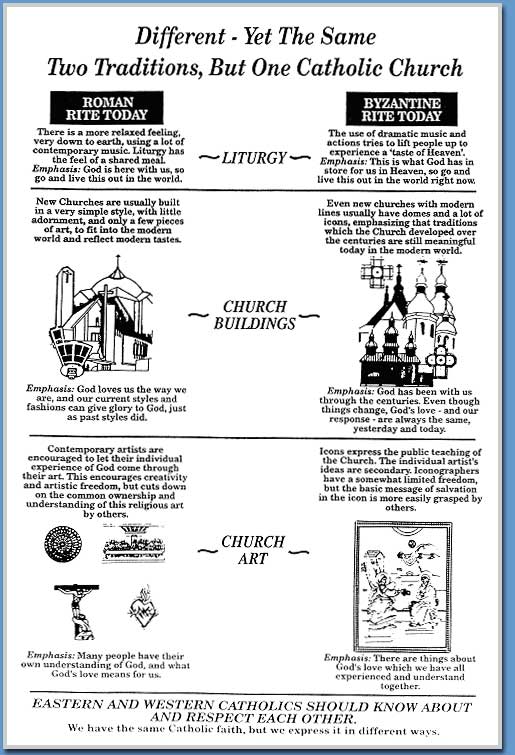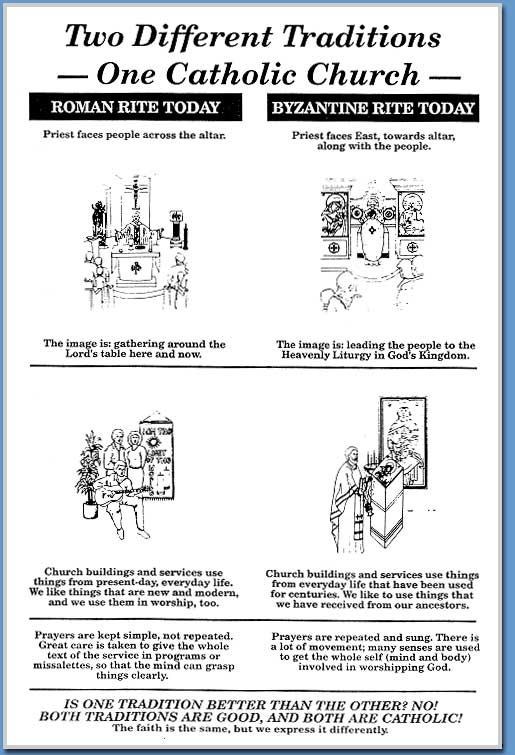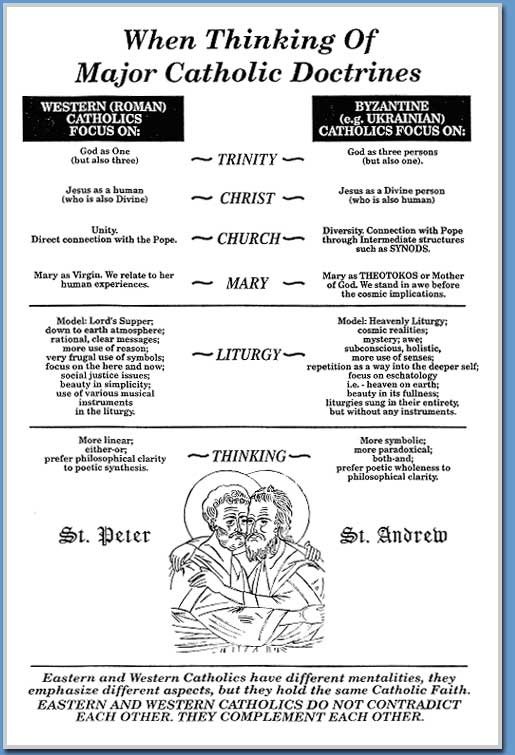

|
St. Mary's Ukrainian Catholic Church Basilian Fathers |
|
Pastor: Fr. Josaphat Tyrkalo, OSBM
In Residence: Most Rev. Severian Yakymyshyn, OSBM (Bishop Emeritus)
|
|
550 West 14th Ave. Vancouver, BC V5Z 1P6 Canada P.: 604.879.5830 F.: 604.874.2727
|
|
|
|
Welcome to the "Our Faith" section which explores our Ukrainian Catholic Faith, traditions and beliefs. | |
 | |
 | |
 | |
|
Ukrainian Christmas Christmas is one of the most cherished Celebrations that the Ukrainian people celebrate. Christmas celebrations begin on Christmas Eve, December 24 (as per the Gregorian Calendar), which is a day of vigilance, prayer and fasting. The entire family is involved in the preparation of the traditional Christmas Eve Supper (or Sviata Vecheria - literally "Holy Supper"). When the first Star in the eastern sky appears, it marks the beginning of the ancient and memorable rituals. The father of the home may bring in the "Didukh" (Grandfather Spirit) - a sheaf of wheat wrapped with an embroidered towel - which is placed under an Icon in a place of honor, in the home. The decorated sheaf of wheat - a symbol of the harvest - symbolizes the ancestors of the family. There may be spread on and around the table, a thin layer of hay. The table is then covered with a white embroidered tablecloth. All this is symbolic of the manger in which Christ the Savior was born. At the center of the table, symbolizing the Holy Trinity, are three round "kolachi" (braided loaves of bread). In the center of the loaves is candle which symbolizes Jesus Christ as the Light of the World. The entire family gathers by the table, and the head of the family leads in prayer - usually the singing of the Nativity theme. After this he greets the family with the traditional Christmas salutation: "Christ is Born!". The family responds "Let us glorify Him!". |
Everyone then sits down to partake of the Holy Supper, which consists of twelve meatless dishes. The twelve dishes honor the Twelve Apostles as they gathered for the Last Supper. The first and most indispensable of the twelve courses is "Kutia." The ingredients of which are wheat, honey, poppy seeds and nuts which symbolize the fertility of Godís nature. Consequently, Kutia is assumed to symbolize prosperity peace and good health. The order of courses, and even the courses themselves, are not uniform everywhere, for each region in Ukraine had its own traditions and were subject to the ingredients available to it. However, the following are commonly served: borsch, fish (served in different ways), holubtsi, pyrohy, mushrooms with sauce, stewed dried fruit; pastries and the like. After the Holy Supper the family joins in singing of Christmas carols. Later in the evening the whole family goes to church for the service of Great Complines (the very moving and unforgettable service where one hears sung majestically, "God is with us"). At about midnight, the solemn Divine Liturgy is celebrated; it forms the kernel and crown of the entire Christmas celebration. At the conclusion of the Divine Liturgy, the faithful approach the altar for myrovania (a blessing with Holy Oils). |
|
Epiphany - The Feast of Jordan
In the Byzantine rite, the Feast of Epiphany (also called the Feast of Jordan) commemorates Jesusí baptism in the river Jordan and the revelation (epiphany or manifestation) of the most Holy Trinity. On the Feast Day in Ukraine and now in Canada, the priest and faithful made a procession from the Church to a nearby lake, river, spring or well. Once there a Cross was cut out of the ice and a there the solemn ceremony of blessing took place. Here in Vancouver, due to the seasonably warmer temperatures, this custom is symbolically observed in the Church. The Great Hallowing of the Waters is a magnificent ritual that is carried out twice: first on the vigil of the Feast (the eve of Epiphany) and then on the Feast Day itself. A container of water, which may be adorned with evergreens, is placed on a low table in front of the Altar. Then follows a ceremony which includes:
|
At the conclusion of the ceremony, the priest immerses the hand cross into the water during the singing of the troparion of the Feast. Following this the priest sprinkles the people and church with the newly-blessed water. Following the celebration, the faithful are invited to approach and drink some of the holy water, and then fill their containers. They take the water home for various purposes such as; to bless the sick , to bless people on special occasions (anniversaries, etc), to avert calamities such as fire and inclement weather. At the traditional Supper on Epiphany Eve (or Schedrij Vecher), the faithful drink this water. After the ceremonies in church and the following day and weeks, the priest attempts to visit the homes of the faithful and blesses them with holy water. We should value the efficacy of this holy water, for if we have faith and devotion, the holy water confers actual graces, restrains the power of the devil and remits venial sins. |
|
Lent, The Season of Repentance
Lent or the Great Fast begins on the Monday, seven weeks prior to Easter Sunday. It is regarded as a time for doing penance through the means of prayer, fasting and almsgiving. The Ukrainian Catholic Church has always considered the doing of penance a necessary condition for salvation. In the past faithful were required to conduct severe forms of fasting and abstinence during the forty days leading upto Easter Sunday. However, the Church has recognized the continuous change in society and as such has called for different expressions of penance. As such there has been a greater relaxation of the laws of fasting and abstinence but in it's place a greater attention to prayer, meditations and almsgiving has been made. Ukrainian Catholics are today obliged to observe Lent in the following manner. On the first day of Lent and on Good Friday, persons between the ages of 14 and 60 are obliged to abstain from all meat and dairy products. Every Friday during Lent is a day of abstinence from meat. Public dancing and other loud secular entertainments are strongly discouraged. As an expression of penance during Lent, Ukrainian Catholics are required to conduct prostrations (called poklony in Ukrainian). A prostration is an accentuated form of bending the knee - an act of inclining the whole body to the ground. These penitential prostrations are performed as the followingpenitential prayer of St. Ephraem Syrus is sung or recited: "O Lord and Master of my life, grant me not a spirit of slothfulness, of negligence, of lust of power, of vain babbling. But vouchsafe unto thy servant the spirit of continence, of meekness, of patience and of love. Yea, Lord and King, grant that I may perceive my transgressions and judge not my brother, for You are blessed forever and ever." In addition, Ukrainian Catholics during Lent are encouraged to attend the following penitential services: Sorokousty: Weekly service commemorating the deceased members of the parish and individual families. Veneration of the Cross: On the 3rd Sunday of Lent, a solemn exposition and veneration of the Cross takes place during Matins or just before the Divine Liturgy. The Cross remains on the Tetrapod for veneration during the whole week. During this period the hymn "We prostrate ourselves before thy Cross, O Lord, and we praise Your holy Resurrection," is sung accompanied by a profound prostration. This practice reminds us of Christ's sufferings and encourages us to persevere in our Lenten resolutions and penances. Holy Week Services The annual commemoration of Christ's sufferings, Death and Resurrection begins on the Saturday before Palm Sunday, the Saturday of Lazarus' resurrection, which is symbolic of Christ's Death and Resurrection. Holy Week services in the Byzantine rite are lengthy, contemplative and deeply penitential as we relive the mystery of our redemption. The services conducted within the Byzantine rite during Holy Week are as follows: Palm Sunday On this day, pussy willows are blessed and distributed to the faithful. The pussy willows symbolize new life. On this Sunday, each Christian is reminded to follow Christ in His humble path of sacrifice and self-denial. Monday, Tuesday, Wednesday On these days the Lenten structure and tone of the liturgies stress the importance of repentance and the need of vigilance in prayer. Holy Thursday This day commemorates the institution of the Holy Eucharist, and the priesthood. The evening service of Passion or Strasty is conducted during with the 12 Gospels on the Passion and Death of our Lord are Read. |
Good Friday
The outstanding and moving service held on this day is the solemn Vespers with the burial procession bearing the Holy Shroud or Plashchanycia. After the procession made three times around the Church, the shroud is laid out for veneration on a replica of the sepulcher. In the evening the service of the Jerusalem Matins is celebrated. Holy Saturday Spent in silent awaiting and preparing for the great feast of Christ's Resurrection. Within our Parish, a prominent feature of Holy Saturday is the blessing of Easter Baskets containing the traditional Easter Foods to be eaten Easter Morning. The Ukrainian Easter Basket should contain: Paska (Easter Bread), eggs, kolbassa, butter, cheese, beets, horseradish, decorative Ukrainian Pysanky. Easter Sunday - The Resurrection Referred to by Ukrainian Catholics as "The Resurrection of the Lord", the most Joyous day of the Ukrainian Catholic Calendar begins with a pre-sunrise Resurrections service. The Service is conducted outside the closed doors of the church in symbolic reference to Christ's closed tomb. Upon entering the church, the faithful triumphantly sing the resurrection hymn "Christ is Risen" "Hrystos Voskres". This is a victory hymn as it proclaims Life itself killed death. For Ukrainians, Easter is a harmonious blend of cultural practices and religious observances. Some of the customs now observed derive from Christian practices, and some from the pre-Christian days. Our ancestors celebrated the coming of spring and the sun in springtime. Thus, there are ancient and deeply ingrained traditions incorporated into the present-day Byzantine liturgical form of worship. For this reson, the Feast of Resurrection abounds with various religious, semi-religious, and cultural rituals. The triauphal jubilations of Easter Sunday in the Ukrainian Church are aptly matched by the reality of new life in springtime after the short days and dormancy of winter. This new life is expressed in the traditional "pysanky" or Easter eggs. In the Pre-Christian era in Ukraine, these eggs represented the new life of springtime. With the advent of Christianity, these egss became the symbol of Christ's Resurrection. On this great day also, spring rituals were performed with songs and dances called the "hayilky" or "vesnyanky". But the prime item was and is the Paska - the ritual meal consisting of the contents of the Easter Basket blessed on Holy Saturday. The ritual meal begins with the reciting or singing of Easter Grace. The family then takes one of the blessed eggs and divides into sufficient pieces for all members of the family to partake in. Prior to eating the egg the Head of the Family greets all members with "Hrystos Voskres" and the family responds "Voistino Voskres". The family then sits and partakes in the Easter Meal. Thomas Sunday On Easter Sunday a round loaf of bread (called the Artos - the symbol for the bread of eternal life) is covered with a metal plate bearing an Icon of the Resurrected Christ and is blessed following the Divine Liturgy. The Artos is reserved on the Altar for the entire week. On Thomas Sunday (the Sunday following Easter) the Artos is cut into small cubes and distributed to the faithful following the Divine Liturgy. Following the Diving Liturgy on Easter Sunday, the parish gathers as family and partakes in a symbolic Easter Dinner called Spilne Sviachene (or blessed meal) and is comprised of the same food which was blessed on Holy Saturday. |
|
If you have questions or suggestions please email webmaster@stmarysbc.com. | |